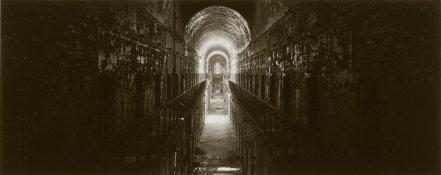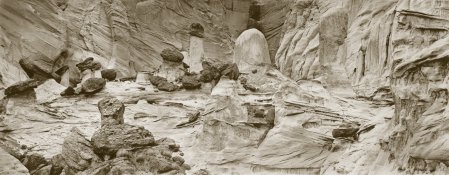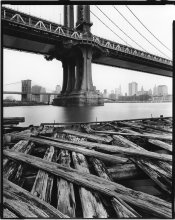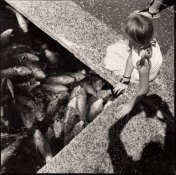I'm not a believer in magic bullets, per se, but I am a believer in using processes designed to get specific results reliably.
What I'm getting at here is that you seem to expect a very specific result and expect to print in a very specific way, it would be helpful to understand that context.
I'm wondering for example, given that you are manipulating the shape of the curve (bending the shoulder to manage the highlights), it seems to me that to use your system and get both shadows and highlights to fall properly on paper (as a straight print), would require a camera exposure within a pretty tight window. Not that that is a problem, but it's not every bodies style of shooting either.
Mark, I think you have many of the basic concepts contained in your post but may not understand why or how they are linked with respect to this process and the silver gelatin end result.
I have attached two 7x17 pix which were early results of the Semi-Stand process, much has evolved from that time but the basic principles prevail.
The darker shot was exposed @ the Eastern State Penitentiary detail from Zone 2 all the way through Zone 15 which were measured prior to exposure. The second, a higher key image was metered with no more than 3 zones of tonality difference. This neg was developed for one hour and prints with relative ease on a normal grade of enlarging paper.
I chuckle when I hear others say "your just pushing tones around", well of course I am! A good friend said just that to me 10 years ago when I shared this technique with him. He a huge George Tice fan, in fact the producer of the current Tice documentary. Another friend, my own mentor, a Tice workshop attendee back in the early 80's told of Tice's method, "if the negative prints too harsh (without highlight detail) on grade 3 then switch to grade 2" rather than using any printing tricks to allow the use of grade 3 for the final print.
Back in 2004 when I shared this Semi-Stand technique with the Tice friend ("your just pushing tones around") I said to him, do all of your negatives print on grade 2? or do you use grade 3 / 4 sometimes? "no I have three grades of paper I use" to which I said "well your just pushing tones around". To this day I'm sure he doesn't embrace this type of contrast control, his prints are beautiful, so are mine, the difference and it is a huge difference to me, my process allows total contrast control in lighting situations most photogs would be hopelessly at a lost to make a suitable negative.
Thank you for that soap box time, I usually choose not to go this in depth with my process as their are so many doubters out there who I choose not to expend precious time explaining myself, I don't get that vibe from those in this discussion.
First, while I am not that knowledgeable in many of the other processes almost all of which demand a negative of considerable higher contrast index, leaving the Silver Gelatin print by itself if you will, that is to say the S Gelatin process demands a very unique negative and is integral to the need for this specialized technique of Reduced Agitation Film Development. Right there may provide some insight as to why this technique receives the detractors it does, once again, THE SILVER GELATIN NEGATIVE IS DECIDEDLY DIFFERENT THAN ALMOST ALL OTHER PROCESSES!!!!! to produce high quality results.
Let's break the whole photography "capture" into constants which are NOT in our control. Let's not consider filtration, film characteristics, lighting conditions and adjustable paper contrast, while they do offer some flexibility when talking in the context I'm talking about they are very small contributors. That said, my whole methodology in general is based on adding many small gains to become a significant directional technique.
Let me say from the start, the single most difficult component of any photograph to control is MICRO CONTRAST, or the contrast as grey tones transition from light to dark or vice versa with ONE ANOTHER!
SCENE CONTRAST... and one's decision with how to portray it, creative or otherwise will begin the process on how to capture the in camera negative.
Contained within SCENE CONTRAST is the darkest value and lightest value, both our decisions where we put them, if you use that as an argument against the process then I'll not win you over.
FINAL POSITIVE PROCESS... in this case Silver Gelatin, comparatively speaking with other processes requiring a much softer negative, to a large degree Final process dictates Film Development
THE ABOVE are products of our likes and tendencies, I am suggesting with this process one's personal likes can be expanded to possibilities heretofore not possible if not for this technique. (RADevelopment)
BELOW ARE parameters which do enjoy some flexibility predicated on one's choices, again, with the Reduced Agitation Technique, these parameters can be significantly expanded, again heretofore not possible if not for RAD.
FILM SPEED... dictated by the film one chooses, to a large degree dictates, aperture / shutter speed
MICRO CONTRAST... dictated by the particular scene itself and final paper contrast, NOTHING ELSE! Save for bleaching or masking!
NEGATIVE HIGHLIGHT DENSITY... dictated by in large by the final process one uses, in my case Silver Gelatin
With regard to a "magic bullet" of course there is no such thing, however, when you examine how Reduced Agitation Film Development impacts the unique set of challenges that I choose, i.e. extremes of contrast rendered on the least forgiving final process, consider this:
Most Large Format photographers, all things constant would opt for a higher Film Speed than 100 - 200 ISO
RAD maximizes Film Speed, most cases Box Speed, FP 4 for 160 ISO, HP 5 @ 400 ISO in my case.
Highlight Density, (remember, using the Silver Gelatin process scene contrast and highlight retention is almost always out of synch.
Micro Contrast, the most elusive of parameters to control is the one which is impacted to the greatest degree with RAD. To be sure, there is testing and trial and error, at least in my case, however far out weighed by the final control realized.
So Mark, to your point, I am designing my negatives so that as much of the negative's tonalities print on the straight line of the paper is a fairly succinct way of describing what the process does for me.
Certainly, the process is not for everyone, it does however provide the most control for negative / contrast control in the wet process that I can imagine and does not in any way deserve the generalized comment of "Your just pushing tones around"! I like to think of it as being Creative!
Cheers!















